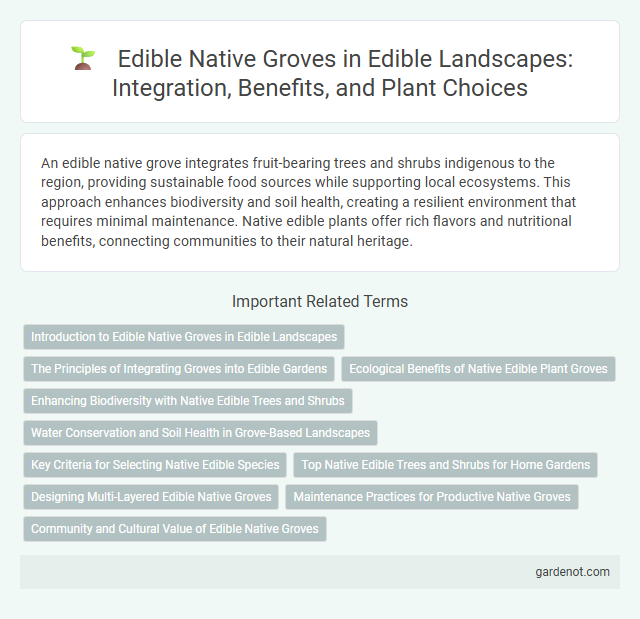An edible native grove integrates fruit-bearing trees and shrubs indigenous to the region, providing sustainable food sources while supporting local ecosystems. This approach enhances biodiversity and soil health, creating a resilient environment that requires minimal maintenance. Native edible plants offer rich flavors and nutritional benefits, connecting communities to their natural heritage.
Introduction to Edible Native Groves in Edible Landscapes
Edible native groves combine the beauty of indigenous plant species with the practicality of food production, creating sustainable and resilient ecosystems. These groves feature a diverse array of native trees, shrubs, and groundcovers that provide fruits, nuts, and edible leaves while supporting local wildlife and soil health. Integrating edible native groves into edible landscapes enhances biodiversity, reduces water usage, and fosters a deep connection to regional ecological heritage.
The Principles of Integrating Groves into Edible Gardens
Edible native groves harmonize biodiversity with sustainable food production by prioritizing local plant species that thrive naturally in the environment. Integrating groves into edible gardens involves designing layers of canopy, understory, and ground cover to maximize space, soil health, and water retention while supporting native pollinators and wildlife. Applying principles such as mimicking natural ecosystems, enhancing habitat connectivity, and selecting drought-resistant native plants creates resilient, low-maintenance edible landscapes that promote ecological balance.
Ecological Benefits of Native Edible Plant Groves
Native edible plant groves enhance biodiversity by providing habitat and food sources for pollinators, birds, and beneficial insects. These groves improve soil health through natural nutrient cycling and reduce erosion with deep-rooted native species. Their ecological benefits also include carbon sequestration, supporting climate resilience and ecosystem stability.
Enhancing Biodiversity with Native Edible Trees and Shrubs
Integrating a native edible grove into landscapes significantly enhances biodiversity by supporting local ecosystems with indigenous trees and shrubs like pawpaw, elderberry, and serviceberry. These plants provide essential habitat and food sources for native pollinators, birds, and insects, fostering ecological balance. Cultivating native edible species promotes soil health, water conservation, and resilience against pests, creating a sustainable and vibrant edible landscape.
Water Conservation and Soil Health in Grove-Based Landscapes
Edible native groves enhance water conservation by utilizing deep-rooted native plants that improve soil infiltration and reduce surface runoff. These groves support soil health through organic matter accumulation and microbial diversity, promoting nutrient cycling and carbon sequestration. Integrating edible native species in grove-based landscapes creates resilient ecosystems that maintain moisture balance and sustain long-term agricultural productivity.
Key Criteria for Selecting Native Edible Species
Key criteria for selecting native edible species in an edible native grove include adaptability to local soil and climate conditions, ensuring robust growth and minimal maintenance. Species with high nutritional value and multiple uses, such as fruit, nuts, or medicinal properties, maximize the grove's productivity and sustainability. Favoring biodiversity by incorporating a mix of trees, shrubs, and ground covers fosters ecosystem resilience and supports native wildlife.
Top Native Edible Trees and Shrubs for Home Gardens
Top native edible trees and shrubs for home gardens include pawpaw (Asimina triloba), elderberry (Sambucus canadensis), and serviceberry (Amelanchier spp.), valued for their nutrient-rich fruits and adaptability to local climates. These species contribute to biodiversity, support native pollinators, and provide seasonal yields of vitamins and antioxidants. Integrating such native edible plants enhances soil health, reduces irrigation needs, and creates sustainable, self-sufficient edible landscapes.
Designing Multi-Layered Edible Native Groves
Designing multi-layered edible native groves involves selecting diverse native plants that provide multiple food sources across canopy, understory, shrub, and ground layers. Incorporating fruit trees, nut-bearing species, native berries, and edible herbs maximizes yield while supporting local biodiversity. This approach enhances ecosystem resilience, promotes soil health, and creates sustainable, self-sufficient landscapes with year-round harvest opportunities.
Maintenance Practices for Productive Native Groves
Regular pruning and selective thinning enhance airflow and sunlight penetration, promoting healthy growth in edible native groves. Applying organic mulches conserves soil moisture, suppresses weeds, and enriches nutrient cycling vital for fruit and nut production. Integrated pest management using native predator species minimizes chemical reliance, supporting ecological balance and long-term productivity.
Community and Cultural Value of Edible Native Groves
Edible native groves serve as vital community hubs that foster cultural heritage by reconnecting people with indigenous plant species traditionally used for food, medicine, and rituals. These groves promote biodiversity conservation while offering educational opportunities that strengthen local identity and intergenerational knowledge sharing. By hosting communal gatherings and harvest events, edible native groves enhance social cohesion and support sustainable food systems deeply rooted in cultural values.
Edible native grove Infographic

 gardenot.com
gardenot.com